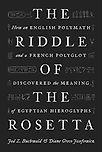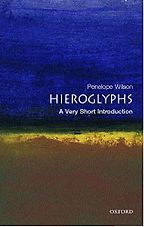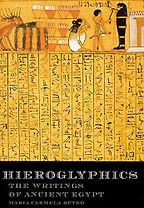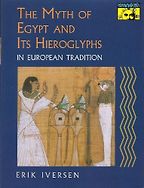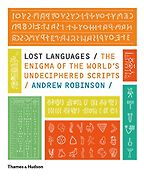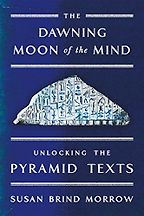Before we get to the books: the word ‘hieroglyph’ comes, I suppose, from the Greek words for ‘sacred’ and ‘carving’. What were hieroglyphics, in the end?
The hieroglyphs are one of three scripts used in ancient Egypt. Another is hieratic, a shorthand version of the hieroglyphs that’s used on mummy wrappings and other sacred objects and comes in a few forms. Then there’s Demotic, which is a relatively late form of Egyptian writing that was used for everyday purposes, e.g., legal documents. A fourth form of the language, Coptic, has long been considered a late form of Egyptian as well as being the liturgical language of the Coptic church. Although Coptic is written in Greek letters, it contains fossilized forms of the ancient language. This was something that Jean-François Champollion, the Frenchman who eventually deciphered hieroglyphs and one of the two main characters in our book, was very concerned to learn about, because he believed it could be used as a key to unlock the hieroglyphic script.
The Egyptians called the hieroglyphs medu netjer which means the words of the gods. The hieroglyphic script is used in formal, religious contexts, which is why hieroglyphs appear on temple walls and other places where the world of the divine met the world of the human. For instance, in the Pyramid Texts of Unis, which appear on the interior walls of a tomb in Saqqara, the hieroglyphs appear to guide the spirit of Unis as he makes his way in the afterlife.
Like any writing system, hieroglyphs developed over time. There’s Old Egyptian, which is from around 3000 BCE. That transforms a 1000 years later into Middle Egyptian, which is what the Pyramid Texts of Unis are written in. The latest hieroglyphic script we have is from 495 AD. The history of this script stretches over millennia and the script naturally changes quite a bit in the course of that time.
And are hieroglyphics more like an alphabet or like Chinese characters?
The script contains different kinds of signs. They can be ideograms, pictures of things that they represent. They also can have phonetic values. Some of the signs are determinatives, signs that refer to other signs and tell you what the function of those other signs is. Determinatives help you distinguish between a sign that’s meant to stand simply for what it depicts, like a bird or a plant, and a sign that may mean something more metaphorical or should be read in a slightly different way. The determinatives help to resolve that ambiguity.
“The Egyptians called the hieroglyphs ‘medu netjer’ which means the words of the gods”
I should say that I’m not an Egyptologist, so my understanding of all the Egyptian scripts is very much shaped by what I needed to know in order to work on our book. A modern Egyptologist will have a more complete and nuanced view of the scripts, their history and development. In our book, we worked to convey the basics without overwhelming readers with a lot of extraneous detail.
Your book is The Riddle of the Rosetta: How an English Polymath and a French Polyglot Discovered the Meaning of Egyptian Hieroglyphs, which you wrote together with historian of science Jed Buchwald. The book follows these two men, Jean-François Champollion (1790-1832) and Thomas Young (1773-1829), who were competing to decipher this ancient language. Once the Rosetta Stone was found, how long did it take them to figure out the meaning of the hieroglyphs?
A French soldier discovered the Rosetta Stone in a fort in Rosetta in 1799. It was held by the French for a while and eventually made its way to London. At that point, engravings of the stone began to move around, and people started to understand what was on the stone and what these inscriptions were. From then it took a little over 20 years for Champollion to come to the decipherment.
In the meantime, the stone itself was in a closet in the London Society of Antiquaries. When it finally arrived at the British Museum, it was necessary to reinforce the floor so it could be safely displayed.
What is the Rosetta Stone, exactly?
It’s an upright slab of black stone called granodiorite. Archaeologists call this kind of object a stele, that is, a slab that bears a commemorative or official inscription. A gravestone is an obvious, ordinary example of a stele.
The Rosetta Stone was a formal artefact, essentially a government document. It’s one of a series that was created to disseminate an agreement issued by a council of priests affirming that they’ve subscribed to the cult of Ptolemy V. The inscription showed up in a lot of different places on a lot of very similar stones, and additional copies have been found.
I also should say that the inscription is trilingual. It appears three different ways on the Stone, in Greek, hieroglyphics, and Demotic. This neat feature is what made the artefact so attractive to Champollion and his rivals. The first thing that anyone did was to start translating the Greek. Then they supposed that all three of these inscriptions—the Demotic, the Greek and the hieroglyphic—conveyed the same message. This supposition led them to compare the Greek text to the Demotic and the hieroglyphic to try and find correspondences that they could make use of to translate the rest.
It’s a wonderful book you’ve written. It’s so detailed, just looking at these two individuals and tracking their experience as they work out the meaning of the hieroglyphs as well as their disputes and all the other stuff that’s going on in the background, particularly in France. Why did you embark on it?
The book grew out of a tendril from our research from our previous book, The Zodiac of Paris, which was about an Egyptian temple ceiling that was basically exploded out of a temple in Egypt and brought to France in 1821. In that book, Champollion played a small role. He looked at this temple ceiling and weighed in on a controversy that had grown up around it. The temple ceiling seemed to be a picture of the sky, at the date of the temple’s creation and there was a fight about whether or not this was the case. Astronomers used elaborate calculations to argue that the ceiling was extremely old, preceding by millennia events described in the Bible. Theologians argued the opposite position, that the ceiling could not possibly be that old, or even very old at all. The controversy briefly captured the imaginations of everyone in Paris. There was even a vaudeville play about it.
Get the weekly Five Books newsletter
When the fight came to Champollion’s attention, he wrote an article dismissing both positions, saying essentially, ‘This is an idiotic discussion on both sides.’ He happened to mention determinatives in that publication, and soon afterward he arrived at the decipherment. So, we began by being interested in what Champollion saw in the temple ceiling that he could then correlate to his research on the Rosetta inscriptions. Historians of the decipherment tended to gloss over Champollion’s work on the Dendera zodiac. We wondered if they were missing a crucial step in the development of his point of view on the hieroglyphs and his system of decipherment. From there, it was a short step to, ‘OK, we’re going to have to do a whole book about the decipherment in order to make sense of this.’ In the end, that moment where Champollion weighs in on the temple ceiling does play a role in our book. But it was not the central role that we’d envisioned when we started. Rather, it was one of a whole series of interlocking insights.
And The Riddle of the Rosetta took a decade to write?
Yes, it did. There was so much material to digest. There is a huge literature on the decipherment of the hieroglyphs, much of it quite technical and written by Egyptologists rather than historians, so it was often difficult to disentangle the material that was historically useful from the reflections on how and why the historical stuff differed from the present dispensation. And then there were the languages. Both Champollion and his main competitor, Thomas Young, were master linguists who were comfortable in multiple ancient and modern languages. Keeping up with them was a huge challenge. I was up at 4am every morning for a good long time learning Coptic. Not that I have much Coptic. But I needed enough to look at Champollion’s Coptic notebooks and figure out what he was doing with the language in relation to the scripts. This kind of intensive study takes a while.
It’s really, really impressive. Let’s go through the books you’ve chosen, specifically about the world of hieroglyphics that you entered into. Your first recommendation is Hieroglyphs: A Very Short Introduction by Penelope Wilson, which you’re suggesting as the book to start with, if you know nothing about the subject. Tell me a bit about it and why you like it.
I love all of the books in the Oxford Very Short Introduction series. In about 100 pages they really give you everything you need to ground yourself in a subject. And that’s certainly the case with Wilson’s tiny volume on hieroglyphs. She packs a lot into the book. She gives an overview of the nature, history and function of Egyptian hieroglyphs. She covers all the basics, everything you need to know about them if you’re starting from scratch.
If you were to visit the British Museum and take a close look at the Rosetta Stone, or you were going to take a walk through the Egyptian gallery at the Louvre , it’s a book you might read before visiting, so that you could know a little bit more about what you were looking at before you got there, and be able to make more sense of what you see.
“According to Susan Brind Morrow…hieroglyphs are actually easy to learn”
I do have a favourite chapter in Hieroglyphs: A Very Short Introduction, which is about the status of names in the hieroglyphic script, their role in ancient Egyptian culture and its writing. Names had real power in ancient Egypt. And if you look closely at the Rosetta Stone, one of the things that’s noticeable right away is that there are a lot of names on it. And this is true of a lot of inscriptions, there are a lot of names and they’re mostly names of gods and rulers. Wilson says this is because names were thought to contain the essence of a person. To have your name carved in hieroglyphics on a temple completed your identity in a way that nothing else could. It conferred power in that way.
The removal of a name from a temple was a serious erasure. There are even inscriptions where a pharaoh will issue warnings like, ‘if you scratch my name out of this, it won’t be lost, there’s divine power in the name that is sufficient to reinscribe it, even if you try and take it away.’ These amazing kinds of inscriptions that are intended to really preserve the power of an inscribed name. This is one of the things I find so interesting about hieroglyphs, that they do more than just record. For the ancient Egyptians, they confer other kinds of power, not just memory.
So are they a little bit mystical, for want of a better word?
I wouldn’t go that far, although maybe I should. I think they attest to a real and persistent need for some kind of mirroring, to have an outward consolidation of one’s sense of oneself. To have an outline in the world. That, I think, is something that hieroglyphics did for ancient Egyptians, or at least for those wealthy and powerful enough to have such inscriptions made.
Hieroglyphs: A Very Short Introduction also covers the different types of Egyptian scripts that you mentioned at the beginning and their evolution over this very long period, because we’re talking about 3000 years or so.
Exactly. So, if you were to take a slow walk through a museum and really start paying attention to the dates of the inscriptions that you were looking at, you might be able to see the kinds of developments that she mentions.
Let’s go on to the next book, which is by Maria Carmela Betrò. It’s called Hieroglyphics: The Writings of Ancient Egypt.
This is a wonderful book, full of illustrations. It’s laid out almost like an art book. It is, I think, the best of a number of books that are available to introduce readers to hieroglyphics in a serious way. Betrò doesn’t say much about the grammar or syntax but you can get that elsewhere. What she does do is offer a nice selection of signs from Gardiner’s Sign List, and groups them according to sensible categories. So all the signs for plants are in one place, all the signs for the gods are in another place. Each sign occupies a full page, and the page is laid out in such a way that you can immediately understand the sign’s phonetic value, its function, whether it’s a determinative or not, whether it has a Demotic or hieratical equivalent, and so on.
She also discusses the meaning of the sign in its relation to Egyptian religion. So you really get a sense of the role that each sign plays within this theological system. To read this book from start to finish opens a wide window into the culture. The same themes come up over and over: the afterlife and what happens there, who controls what, as well as a view of ordinary life in ancient Egypt—the kinds of plants and animals that are around, the kinds of instruments people are using to get on with their day-to day-lives, and what sacred significance those things had too. It’s a really nice encapsulation of ancient Egypt through its writing system. You can see a lot of things just by looking at the script.
What is Gardiner’s Sign List?
It’s a list created by Alan Gardiner (1879-1963), a British Egyptologist. He collected all of the hieroglyphic signs he could, about 700 signs, and grouped them. His list is what Egyptologists still use to learn hieroglyphics today. It’s available on the internet, but it’s hard to know what to do with it. Betrò’s book makes it accessible to non-specialists.
How easy is it to learn to read hieroglyphic inscriptions?
According to Susan Brind Morrow—whose work we’re going to talk about—hieroglyphs are actually easy to learn. The syntax is fairly simple and the signs themselves are evocative. On her view, it’s not that hard to learn the language if you understand the culture to begin with. Certain facts about Egyptian life can help make sense of the hieroglyphs. For instance, there is a hieroglyph that looks like a snake with horns. This is a horned viper, which is not at all uncommon in Egypt even now, and it makes a sound like ‘fffffih’ when you annoy it. Susan Brind Morrow once explained to me that the wonderful thing about this sign is that ‘fffffih’ is its phonetic value, and that’s exactly the noise the horned viper makes when it’s about to strike.
“Names had real power in ancient Egypt”
At that same meeting, Brind Morrow pointed out a number of other correspondences that were similar. I don’t remember them all, but I would hope that she’s right. The story of the horned viper is such a wonderful just-so story. I want it to be true.
But my concern in writing The Riddle of the Rosetta was not to gain a comprehensive knowledge of hieroglyphics but just to be able to read whatever Champollion and Young were able to read, which was a challenge enough in itself.
So, if you were at an Egyptian temple, could you read the inscription?
No, not reliably. I could sound something out. I can certainly write my own name in hieroglyphs. I can transliterate things. But the inscriptions themselves are so historically specific, I don’t even think I want to imagine that I could reliably say what they said.
Let’s go on to book number three, which is The Myth of Egypt and Its Hieroglyphs in European Tradition (1961) by Erik Iversen, which is about the European reception of ancient Egypt. Tell me about this book and why it’s interesting.
This is an old book, a classic. Iversen was a Danish Egyptologist and in this book he’s looking at the history of the reception of Egyptian hieroglyphics in the West. He starts in Greece, and goes all the way through, up to the decipherment. The way he tells it, it’s almost a history of folly. So he’s got a particular slant, but he does give a nice catalogue of the people who were exposed to hieroglyphs and did something to them or with them in their own cultural context. What I love about this book is that it’s a nice index to the European encounter with ancient Egypt, of who all of the major players are on the stage, even if I don’t always agree with his view of what they were doing with these hieroglyphs.
Iversen is very interested in disentangling historical preconceptions about hieroglyphs from what’s really going on. In our book, we are less interested with that question. We focus on what Champollion and Young thought rather than how their ideas matched up with the present organization of knowledge in Egyptology. But a lot of people are very interested in how things match up. I’ve selected Iversen’s book with that audience in mind.
Another strength of Iversen’s book is that he takes seriously some earlier scholars who have gotten short shrift. So, for instance, he writes about Athanasius Kircher (1602-1680), who was probably the first serious scholar of hieroglyphics in the West. Kircher is a figure of fun to many people—as he was, sometimes, to Champollion—but he did do some important work and Champollion drew on it, although he was careful to distance himself from Kircher at other times.
There’s a more recent book on Kircher by Daniel Stolzenberg called Egyptian Oedipus. I was going to list that, but I chose Iversen instead because it’s less academic and more accessible to general readers. For a reader who is interested in Kircher and these original, serious, almost philological engagements with hieroglyphics, the best thing would be to go on to the more recent book, because Stolzenberg does a nice job of laying out what Kircher was doing with hieroglyphs and connecting that work with his other scholarship and his context.
Generally, what’s your conclusion about the reception of ancient Egyptian culture in Europe down the centuries?
I feel a little bit tragic about it. I always feel a little uneasy walking around cities like Rome and Paris, where so many ancient Egyptian obelisks crop up everywhere. In Rome, there’s one cemented on top of a stone elephant, and the whole assemblage sits in the middle of a small square in the shadow of the Pantheon. The sculptor Bernini was responsible for this construction, including the elephant with its astonishingly swingy trunk and, if I am not mistaken, the brass or iron furbelow that sits atop the obelisk like a hat. I don’t mean to insult Bernini, who I admire, but his treatment of the obelisk makes it so clear that these objects exist in the West only to be recontextualized for local purposes. The effort to re-situate these artefacts in new contexts always strikes me as dissonant and not quite convincing.
I suppose we import things all the time. But these objects still have such a power. An obelisk covered with hieroglyphs is, I think, a powerful object. It seems minimized if it becomes the centre of a roundabout. Its original significance is lost, at that point.
Let’s move on to the next book, which is Andrew Robinson’s Lost Languages. This looks like a lot of fun.
Yes, this is a fun book. Again, I chose it because it’s very accessible. My shorthand title for this book is ‘the pantheon of decipherers’ because Robinson focuses so insistently on the impassioned geniuses at the centre of various decipherments. If you want stories about heroes, here they are.
Robinson begins by outlining three successful decipherments: the decipherment of hieroglyphics, the decipherment of Linear B, the script used in the Bronze Age by the Mycenaean Greeks, and the decipherment of the Mayan glyphs.
In the rest of the book Robinson goes on to talk about decipherments that haven’t been successful and scripts that haven’t yet been deciphered: Linear A, the ancient Mesoamerican script called Zapotec, and Rongorongo, the Easter Island script, just to name a few that he goes through.
It’s really a book for people who love not necessarily the history of any particular decipherment, but the idea of decipherment as a code-cracking exercise. I’m one of those people. I love crossword puzzles, figuring out all the clues and getting the whole puzzle exactly right. And this is a book that very much celebrates that impulse.
In the cases of some of the scripts that haven’t been deciphered yet, what tends to be the issue? Is there just not enough surviving text to be able to figure them out?
Often that’s the issue, that there just isn’t enough text to go on. In the successful decipherments, someone has usually figured out a phonetic key to part of the system and from there things start to fall into place. This was certainly the case with the Mayan glyphs, which were impenetrable until Yuri Knorozov, a Russian, really hit upon the phonetic backing to that script and used that to rebuild this whole set of ideas that gave rise to the decipherment of the Mayan glyphs.
“I was up at 4am every morning for a good long time learning Coptic”
For hieroglyphs the story is similar, as Champollion began his career by using Coptic to chip away at some of the mysteries presented by the ancient Egyptian scripts. As I said, Coptic is this late form of Egyptian, and so he canvassed Coptic sources from late antiquity, looking for Coptic words for ordinary things, like a lotus or a viper. Then he knew the sound that went with that concept and could then take that information and feed it back into what he knew about the hieroglyphic script and see if he could find correspondences that could then be enlarged upon and extended through a larger body of of inscriptions. He wound up with whole notebooks devoted to Coptic words, at times correlated to elements of the various ancient Egyptian scripts. Coptic permitted him to generate theories that he could then test on new inscriptional material. But this engagement with Coptic wasn’t the end of his investigations. Rather, it provided a point of departure for work he did some years later that led directly to the decipherment, as we discuss in our book.
Finally let’s turn to Susan Brind Morrow, who you already mentioned. Her book is called The Dawning Moon of the Mind and it’s about the Pyramid Texts. Tell me about the book and what it’s about.
This is probably my favourite book of the bunch. It may also be the most controversial.
The Pyramid Texts are hieroglyphic inscriptions that appear on the walls of a small, Old Kingdom tomb erected around 2000 BCE in Saqqara. The script is Middle Egyptian, but the story that it tells may actually be much older. According to Brind Morrow, the Pyramid Texts are altogether the oldest surviving body of writing on religious philosophy in the world.
The tomb itself was opened in 1880. The text was ignored for quite a while, and then people started to translate it. The results were not great. Through the 20th century, Egyptologists have attempted to translate the Pyramid Texts and Brind Morrow found all of these efforts unsatisfying, some markedly so. She also identified a bias in existing translations where translators presuppose that the writers of the Pyramid Texts were not very sophisticated, and conclude that this was a primitive document. That bias gave them a lot of room to set the bar very low for the author of the Pyramid Texts. It gave them a lot of room to leave a lot of gibberish in their translation. Another way to put it might be that they didn’t ask very much of themselves as translators. Having found a number of absurdities in the various translations, she decided to take it on herself.
She’s trained as a classicist, but she lived in Egypt for quite a while and she has expertise in Egyptology. She’s also a poet, so she’s got a sense of how poetic verses work. One of the first things she noticed in looking at the Pyramid Texts is that there are a series of separations that appear, so that the hieroglyphs seem to be grouped. She sees this as evidence of versification, that each group represents one verse in a long poem.
The whole assemblage seems to be a sequence of prayers. What’s happening is that Unis, the dead person whose tomb this is, needs to leave his body. To do so, he needs to utter a set of prayers, and these are on the walls of the tomb. The idea is to move his spirit out of its bodily encasing and elevate it into the sky where it will live on as a star. So there’s this stepwise progression of his spirit that he’s supposed to go through and the text narrates that process in highly symbolic form.
I looked into the Pyramid Texts after I read The Dawning Moon of the Mind. And I found myself agreeing with her about the state of the Pyramid Texts before she took them on. The older translations also struck me as absurd. I was surprised by the gibberish, too. It’s important to bear in mind, though, that because this is a very old text, it’s going to be very, very hard to capture just what it says.
At the beginning, she talks about an older translation, which starts with a baboon’s penis. She says that either ancient Egypt was a coarse, stupid and pointless society or the translation is wrong, and she decides to go with the latter.
It starts so absurdly in the traditional version, where there’s the suggestion that a baboon is using its penis to open either the roof of the temple or the vault of the heavens or both at once. It’s unclear what’s going on.
Brind Morrow reinterprets this wild scene by making it sensible. As she explores the signs, she finds a story of what’s going on in the sky, what constellations might be visible. She links this to what we know about the progress of the spirit in the afterlife in ancient Egyptian religion. Unfortunately this is where her own translation gets controversial. Not everybody agrees about how ancient Egyptians looked at the sky and what they might or might not have seen in it. What looks like Orion to me might be part of another constellation entirely to an ancient observer of the skies, even one standing, by some time-travel mechanism, right beside me tonight in my backyard, never mind thousands of miles away, thousands of years ago. So, her translation has a little bit of ambiguity, because we ourselves are not too clear about what was in that particular sky at that precise moment and what would have been noticeable, or salient, to the people producing this body of texts.
Five Books interviews are expensive to produce. If you're enjoying this interview, please support us by donating a small amount.
That said, her debridement of the traditional version of the Pyramid Texts has resulted in something quite beautiful and powerful. The translation has an authority that certainly speaks to me. And the text itself is so important that it should be translated as clearly as possible. I see it as being in the same class as other traditional religious texts. The Tibetan Book of the Dead comes to mind, but also, actually, Kübler-Ross on the stages of grief. In both of those texts, a death produces a moment where it’s necessary to exist in a state of heightened alertness, when one must behave in a ritual fashion and treat the dead person in a ritual fashion as well, taking care to observe all the elements of the ritual in the right order and so on. That’s certainly the case in the Pyramid Texts. There’s something very comforting about that, I think, it’s one of the things that I find so helpful about Susan’s book. I don’t read it as a set of instructions for a dead person so much as a set of meditations for someone who is bereaved. From that point of view, it becomes a wonderful poem of solace, because the stepwise movement from grief and loss to transcendence is so carefully laid out. Certainly it’s being filtered through ancient Egyptian beliefs about life and death, and this alone may make it kind of foreign, but for a grieving person who is willing to read the text a little slant, as Emily Dickinson suggested, it may be a source of comfort.
And is that the closest you’ll get to reading poetry from that period?
There are other Old Kingdom texts—hymns and songs. Volumes of ancient Egyptian myths and legends are available in translation as well. It’s not all government decrees, like the text on the Rosetta Stone. There really is a lot of more culturally relevant material. But, certainly, the Pyramid Texts are very, very special.
I love the quote in your book from Champollion where he writes, “What a distraction indeed for the heart and soul is a grammar that is more than 6000 years old.” I love this idea of studying hieroglyphics as a soothing escape from current events.
In your question I think is a suggestion, which I appreciate, that we are in great need of solace ourselves, living through a global pandemic and with authoritarianism on the march again in so many places. Champollion also lived through some tumultuous times, politically and culturally. But it’s important to point out that his tongue was firmly in his cheek every single moment. Certainly, he found solace in this ancient grammar, but I think also in that statement, he is recognizing how distant from present concerns this study of ancient Egyptian really was. It was something that was absolutely central to his life, but whole governments were being overthrown around him, and he played a role in those revolts, nearly losing his life on at least one occasion. He is a man of the world as well as a scholar. So when he says that, I think he’s speaking to both sides of himself.
Interview by Sophie Roell, Editor
January 29, 2021. Updated: February 1, 2021
Five Books aims to keep its book recommendations and interviews up to date. If you are the interviewee and would like to update your choice of books (or even just what you say about them) please email us at [email protected]

